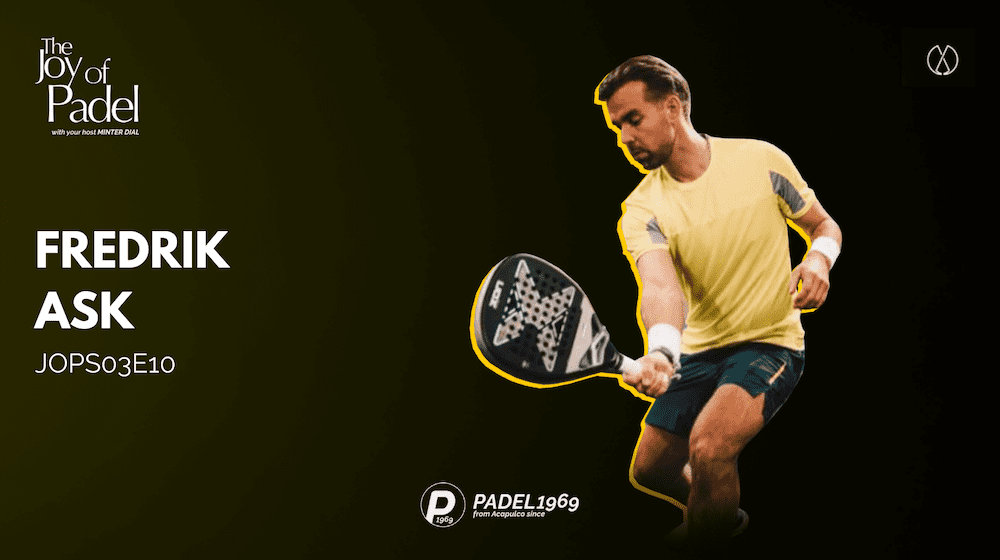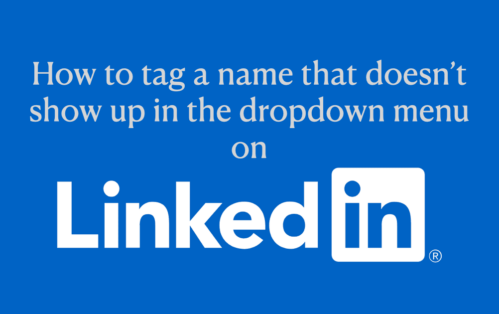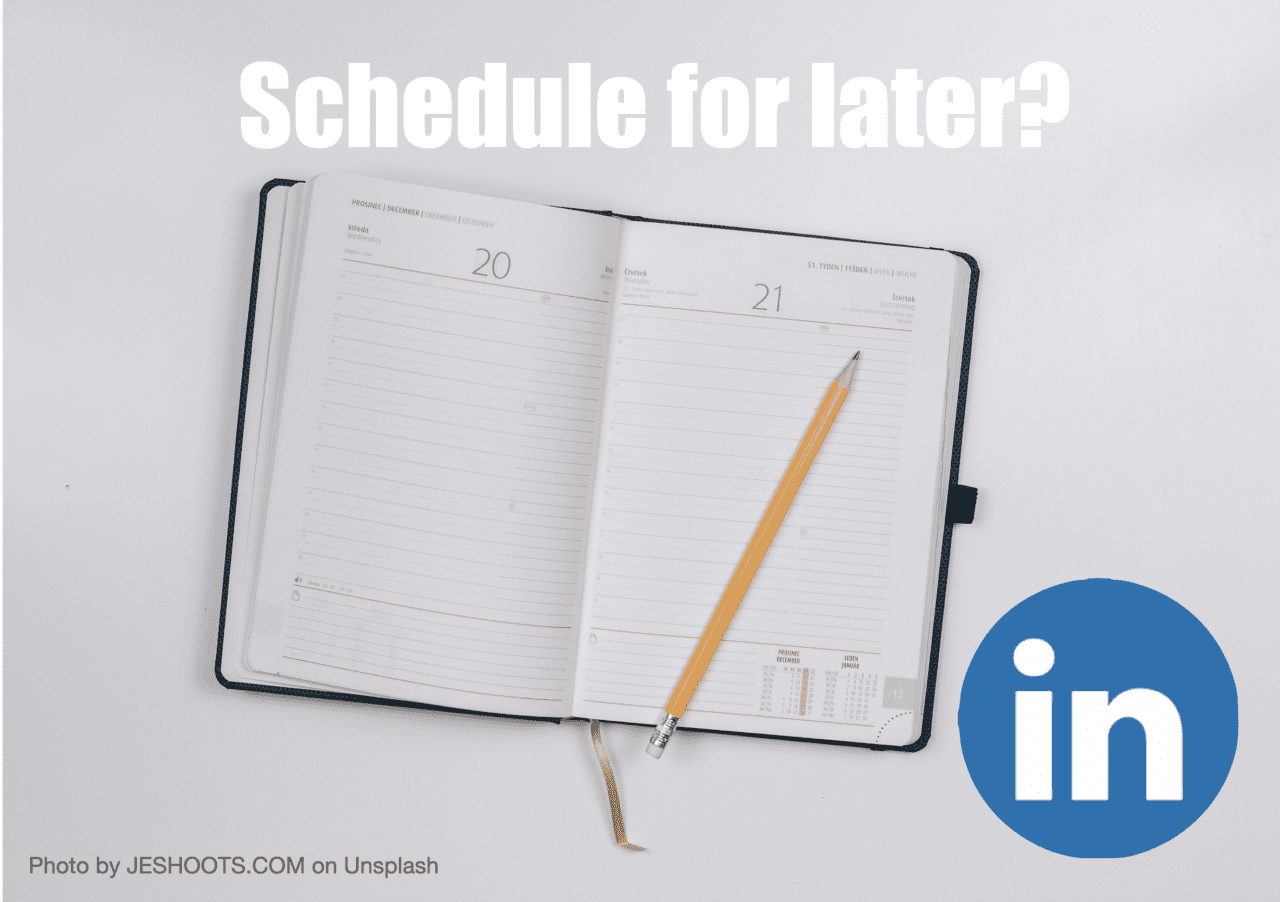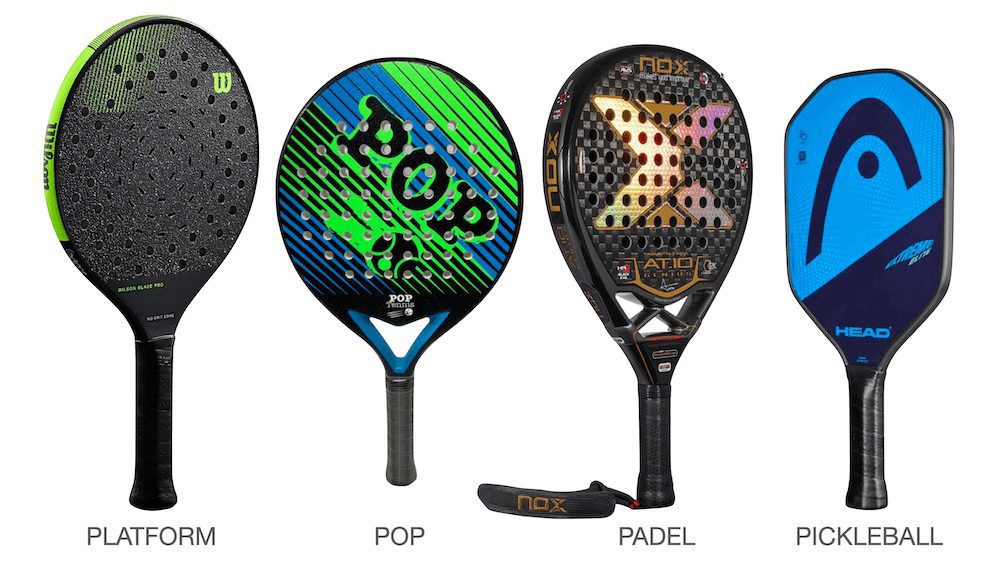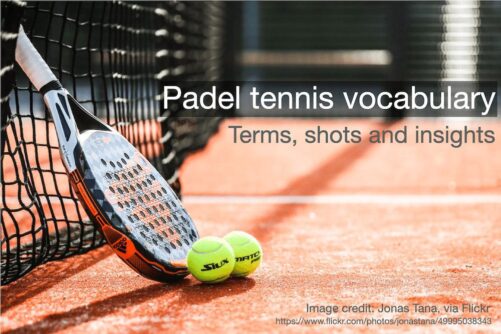The Joy of Padel podcast with Fredrik Ask (JOPS03E10)
In this episode of the Joy of Padel podcast, host Minter Dial welcomes Fredrik Ask, a seasoned padel player from Oslo, Norway. Fredrik shares his journey from professional tennis to padel, highlighting the challenges and learning curves he faced. He discusses the nuances of transitioning from tennis habits to mastering padel techniques, emphasizing the importance of understanding ball trajectories and player positioning. Fredrik also touches on the cultural differences in padel across Europe and the growing popularity of the sport in Saudi Arabia. He offers insights into the complexities of finding the right partner and the significance of off-court relationships. Throughout the conversation, Fredrik reflects on his experiences, the joy of learning through losses, and the continuous evolution of his game. This episode provides a deep dive into the world of padel, offering valuable perspectives for both enthusiasts and newcomers.
To find out more about Fredrik Ask:
- Find or follow on Instagram: @freddyaskofficial
- Find or follow on YouTube
To listen to the show:
To listen to The Joy of Padel podcast, you can use the embedded player above, or go find it on Spotify, Apple Podcasts or any number of other podcasting services listed here.
Send in your questions or reactions:
Please send me your questions — as an audio file if you’d like — to nminterdial@gmail.com. Otherwise, below, you’ll find the show notes and, of course, you are invited to comment. If you liked the podcast, please take a moment to review and/or rate it! ¡VAMOS!
Further resources for The Joy of Padel:

The Joy of Padel podcast is brought to you in association with Padel1969, who are proud to create one of the best padel product and service offerings in the world. Padel1969 believes in passion, joy, and integrity. We respect the DNA and roots of Padel – from Acapulco since 1969. To check all their full offer in padel courts, equipment and savoir faire, please go visit the Padel1969 site.
Meanwhile, you can find Minter's other Evergreen podcasts, entitled The Minter Dialogue Show (in English and French) in this podcast tab, on Spotify, Megaphone or via Apple Podcasts.
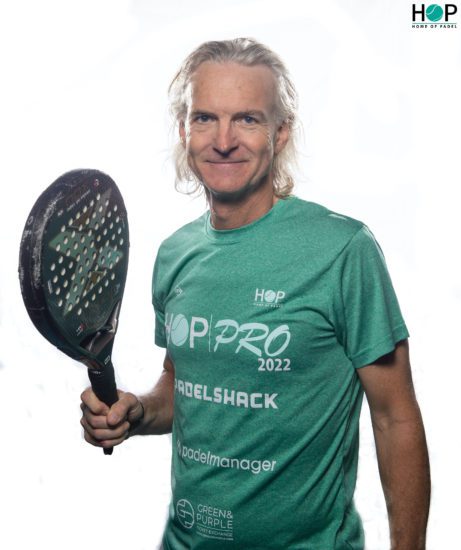
About the host: Minter Dial
Minter Dial is an international professional speaker, author & consultant on Leadership, Branding and Transformation. His involvement in sports has been a lifetime passion. Besides playing 18 years of rugby, captaining athletics teams, coaching tennis and playing squash for his university, he’s been a lifelong player of padel tennis, starting at the age of 10, from the time of its very first public courts at the Marbella Club in 1974.
Then, after a successful international career at L’Oréal, Minter Dial returned to his entrepreneurial roots and has spent the last twelve years helping senior management teams and Boards to adapt to the new exigencies of the digitally enhanced marketplace. He has worked with world-class organisations to help activate their brand strategies, and figure out how best to integrate new technologies, digital tools, devices and platforms. Above all, Minter works to catalyse a change in mindset and dial up transformation. Minter received his BA in Trilingual Literature from Yale University (1987) and gained his MBA at INSEAD, Fontainebleau (1993). He’s author of four award-winning books, including Heartificial Empathy 2nd edition (2023), You Lead (Kogan Page 2021), co-author of Futureproof (Pearson 2017); and author of The Last Ring Home (Myndset Press 2016), a book and documentary film, both of which have won awards and critical acclaim.
It’s easy to inquire about booking Minter Dial here.
Full transcript of interview via Flowsend.ai
This transcription comes courtesy of Flowsend.ai, an AI service for podcasters.
Minter Dial: Well, if that isn’t a great last name. Ask. Ask you a question, Fredrik. Ask. Great to have you on the podcast. And I’ve been, I’ve been enjoying trying to track down where you are and how you’re doing. So, it’s fun to have an opportunity really to exchange. So, in your own words, Fredrik, as I like to ask. Who is Fredrik? Ask.
Fredrik Ask: Oh, difficult question. No, I, I’ve been playing padel now for about nine years. I’m from Oslo, Norway. Have my past, like many other players in, in professional tennis and that’s it. Traveling around the world, hitting these yellow, yellow balls and, and trying to, to stay afloat.
Minter Dial: You know, yellow balls are there. Is it good that we have yellow balls? Should we also have orange balls, green balls? What do you think?
Fredrik Ask: I don’t know. I haven’t thought too much about that, that dilemma. But maybe it could be nice with the change. What’s your thought on that?
Minter Dial: Well, there are lots of the core changes, right. You know, you got your green, your blues, your now your clay courts. So, there’s, I, I feel like there is going to be opportunities for little inventions and innovations on the, on the outside to make the game more entertaining, more varied. I mean it’s already really varied. But for a spectator to watch, maybe that’ll also add some elements of intrigue.
Fredrik Ask: Of course. Yeah, no, I agree. That could maybe do like a white chord and a black ball or a white ball and black cord.
Minter Dial: Well, lots of variety. So, you, you. I’m always curious about the transition from tennis to padel. You began in 2016, you moved from tennis to Padel. What made you start to move? What was the instigation of that?
Fredrik Ask: Oh, I was playing a lot of tennis. Like flying all around the world, playing like low level challenger, future tournament. I don’t know how much you’re into tennis, but I wasn’t at the point where you make, where you make a lot of money, you know, much like 7, 800 in the world ATP and it’s kind of a struggle. So, there was way too much money going out and not too much coming into my pocket. So, I figured as a business decision in the end that we should do something else. And then my plan wasn’t really to play any more racket sport, but then I had all my rackets out on this website after I played tennis, maybe 15 tennis rackets and one Argentinian guys comes on my door and buys all the rackets and I didn’t think more of it. He goes where he goes and half a year later he Calls me. Do you want to play an exhibition match in, in Padel? And at that time I didn’t even know what padel was. I thought first of all we were going to go out, you know, in the ocean and do the padel board thing. But it was in the middle of the winter. And then he just said, no, it’s tennis in a cage. And you’re the only guy I know that does racket sport. So, I figured you would be good for this. So, I went with him and to this exhibition way outside of Oslo. There was an opening of a new club playing as two Argentinians, good players. I had no clue what I was doing. Didn’t use the wall, just smacked every ball. And after that I, I started liking the sport, but I had no idea what I was doing. That was my introduction to Padel.
Minter Dial: Wow. Well, Argentinians, you know, I, I, I, I’ve got a call lined up with Viviana Corquera. I would call her the original Argentinian because that’s, that’s how well she, she instigated of course with her husband padel. And being Argentinian, the Argentinians had that sort of, they always used to have a really specific way of playing. It’s sort of changed with the modern world. But back when I started playing it was, it was very specific, much slower, lots of chiquitas and lobs. I mean, much more than you have.
Fredrik Ask: In the game today.
Minter Dial: And so, you’re a left hander, which I don’t have oftentimes to talk with a lefty because you guys, you screw it up for me, you know, if I’m, I play on the right a lot, So, I’m playing against left handers whenever there is one in the diagonal. And your shots of course are very different for me to handle versus when a righty’s playing. But your transition, So, your first game was, you know, wow, eye opener. But how did you work on shifting from those tennis habits into padel? Because as we know, that’s not easy.
Fredrik Ask: No, I’ll tell you what I did. Like you said, I realized that this is a completely different game, right. So, I kind of knew that I could stick to my tennis ways and kind of play okay, yeah, get away with playing volleys and just blocking everything. But then I understood also that if I want to go some steps higher, you have to like get rid of all those ideas and basically become like an amateur and just start from scratch. Like you doing the whole thing and turning and you know, like slow motion with a coach. Like for years I understood that it would take time. So, I kind of like put away all my tennis things and, and tried to of course keep the volleys and the smashes that what we have, which is good from tennis. But then like being humble and be like, okay, I’m just going to like take in all this new info and actually try to, to understand the game. But it was hard mentally because I knew I could beat a lot of people playing the tennis way. But then at the same time I saw that if I want to go a little bit higher, can play that way, you know, So, it was, it was hard for my own self esteem there, period, feeling like a beginner. But that was my way of just basically just respecting the sport for being a different sport and then trying to, to go from the basics. And I think that helped me also a lot because I see a lot of people, they, especially in Norway level is not that high, but they still playing pretty much tennis inside of the court, you know.
Minter Dial: Right. And now at the level you are, you’re number one in Norway in the top 200 in the world, you can sort of show the tennis player you can eat, make them eat mincemeat because you know how to manage those shots.
Fredrik Ask: Yeah. And also what I didn’t tell you is that after maybe three or four years I moved to, to Madrid and I was training at the diagonal padel Academy there for, for like almost a year because I also understood that you have to go where the knowledge is. So, I went there for, for almost a year and tried to, to learn even more. And that’s when I started to, to, to play on the, the world pilot tour, the one before the premiere and now after the fifth switch, I haven’t been playing that much. So, once, once upon a time I was one of the top 200. But now the last two years I maybe played four or five fibs and mostly doing the money tournaments because I saw that it was a habit of, or could fall back into the one with tennis where you just travel and make no money, you know, and chasing this. So, I was a bit cautious about that. So. So, now it’s mostly money tournaments and coaching.
Minter Dial: Yeah. Well, surely the, the, the issues we’ve seen in the FIP with the men’s side complaining about how it is for the, the players under 30 or you know, worse than 30 because they have to do the qualifiers. They, they don’t know when they’re playing, how they’re playing, how many games are playing. And it’s all sort of arranged around the top players who get the privilege of buys. They know when they’re playing. It’s a lot. It’s a very different gig when you’re outside the top 30.
Fredrik Ask: Yeah. I mean, if you’re ranked 35, 40 in the world, you’re still really, really good. Right. So, you should, you should be earning some money. But the fact that they are not at this point is kind of sad for the sport, I think, especially now when they, they have So, much money pouring into the sport, but everything is being kept, like, right at the top, like you said. So, they have, they have a challenge to do in, in terms of organizing the. The future, also in terms of bringing more people into the sport because it’s not going to be lucrative for people to. I want to play pro pedal. But then knowing that they have to be 20, 30 in the world to make it, to make it go around.
Minter Dial: You know, and if your name isn’t Roma, you know, Ramon or Javi, then your chances of, you know, if your name is Oscar or Minter, the chances of you making it into the top 30 are small. So, you spent a month in, I’m sorry, a year in Madrid. And one of the things I like to think about is the culture of padel. Do you think there is a culture to padel? And if so, is it something that’s merging well into the Norwegian spirit?
Fredrik Ask: Oh, if you mean like how the Spanish people look at Padel, you went.
Minter Dial: Yeah, well, I’m the Argentinians, of course.
Fredrik Ask: Oh. I mean, I know it’s. It’s pretty much up there after football in those sports, but I don’t know, I don’t feel like it has, like, a foothold in the whole, like, community of the country yet. But I guess it’s growing there, too, because I know when I started it wasn’t even that popular in Spain and, like, people were playing, but it wasn’t like a huge sport. But I think now that all other Western and more northern European countries started, I think they also got a boost in their, their own respective countries. Do you agree?
Minter Dial: Well, what I was thinking about more was the culture of playing padel. If you’re in Padel, do you think that there’s a culture of the people who are within the community of padel?
Fredrik Ask: Oh, I think that in the, in the northern parts of Europe is becoming more of, like, a privileged sports and it’s more of like a people sport down in Southern Europe, that, that’s my feeling of the who’s involved. It’s kind of, it’s kind of a shame, though, because I don’t want. I don’t want padel to be like tennis nowhere. It’s only like rich people can play. And 1 hour costs 100, 100 Euro and. And this stuff, you know. But I’m seeing the tendency in. At least in Norway that is people capitalizing on the. On charging huge amounts per hour. And it’s leaning to more. To more towards like a lot more like rich people playing. Not. Not being as people is sport anymore. Well, what about developmental?
Minter Dial: Right. So, now your experience in Madrid, though, you were playing, let’s call it obviously in Madrid at Diagonal. They. It’s. It’s still in a good. I mean there’s a good level. It’s in Madrid. So, it’s an expensive city for Spain because if you go out to the outside, you can get a court for €5.
Fredrik Ask: Yeah. But there, the core cost like €8, €9 at the club. That diagonal was using it So, that I feel like it was way more humble crowd playing Padel in Spain that I see back in Norway and Sweden.
Minter Dial: Well, that’s So, to. To the answer the question, how do I see it? That’s something that I think is important in Padel. That humility, that groundedness. It’s really not about showing off and having a cork up your bum and how, you know, prim and proper. There’s an element of collegiality. And for padel, not just you and your team, it’s the four of you are participating in something bigger.
Fredrik Ask: Exactly. 100 agree with you.
Minter Dial: Cool. So, one of the things I like to. So, you. What I was understanding from what you’re saying, Fredrik, is you is you’re more playing in pay tournaments where there’s a higher pay. It’s not about your FIP ranking anymore. It’s more about making sure you’re having. Making a living. And I totally understand that. What about your game itself? What. What elements of your game is now your strongest element since you’ve been playing now for nine years?
Fredrik Ask: I would probably say like the ability to. To move the people around and like create openings. I have pretty. I would say I have pretty good. Good hands, like touch. But I can mix that up with like a good kick smash and. And keeping the people a little bit on their toes. So, yeah, people don’t know really what to expect when they play against me. Yeah, a lot of variety.
Minter Dial: I tend to say that’s the. That’s what happens with lefties in general for me. Is that the way. And I don’t. It feels like it should be completely the same. You’re Right or left-handed? Yeah, the lefty approach to the ball, for me, it lends itself to be a little bit more quirky.
Fredrik Ask: Yeah, it looks, it looks different, but I think that’s because we see So, many videos all the time with right hand players, So, our mind is kind of like stuck on the image on how a right hand hits the ball and suddenly you see the other way and you’re like, I look strange, you know, But I, I’ve been thinking about the same thing So, many times. Like you say now, do we hit it differently? It looks like it’s different touch to the ball.
Minter Dial: Yeah. Isn’t that, isn’t that curious? I mean, when you’re facing a lefty, I assume you, you must go through the same kind of issues that I go through.
Fredrik Ask: Yeah, in a way, because there’s not that many lefties. So, it always takes me like one or two games to like get adjusted to not hitting the lob in the middle anymore because that’s where he has his match, you know?
Minter Dial: Yeah.
Fredrik Ask: So, yeah, for sure it’s. But I kind of a little bit through him in the court because I know that what he kind of wants to do sometimes as a lefty, So, that can make me anticipate a bit faster than maybe a right hand sometime.
Minter Dial: Right. So, I want to just talk a little bit about this idea of finding space, because I think that that’s an advanced concept is, is finding the space. How do you, how do you instruct? You know, as you’re a coach, you obviously. So, you have a player who’s more technically able. What is it? What sort of, what sort of things should you be thinking about when you’re trying to get to that space, moving the players around.
Fredrik Ask: Yeah, Because I was about to say that really depends on the level of the, the customer. Right. You cannot bring like a concept like creating space into a guy who cannot. You, you got to be able to hit within like half a meter where you aim. I would say to, to like try to do those kind of concepts. But for me it’s a lot about like teaching the people, not where necessarily where the first bounce is all the time, because people are very focused on the first bounce. Right. And hitting hard, but trying to be more thinking one step further. Where does the ball end up after you have one bounce? Because once you move up a little bit in levels, people let the ball go. So, it’s where the second balance is usually that is important. Right. Trying to open the, the mind of the people a little bit and not like getting Stuck in this faster, faster, faster mistake patterns that maybe fast, fast, fast, and then being able to like to slow the tempo down because I feel that’s like the, the majority of people I coach here, they, they often get stuck in faster and faster rallies and not really thinking of where they’re playing, but more thinking about the speed of the ball because it’s cool to hard, you know, well.
Minter Dial: And then on top of that, thinking about where you should position yourself once they get the ball, because chances are at the good level they’re going to get to that ball, even if you’re thinking about the space. But what I’m taking away from you, Fredrik, is first of all, you have to have a certain level, be able to hit within half a meter where you want to hit that ball obviously in. And then second of all, to think about where the ball lands as second bounce. That’s what you need to think about. And those are some really interesting.
Fredrik Ask: I can example, let’s say I’m at the net, right? And I’ll play, I’ll serve and I’ll play my first volley like straight down the middle. But I want to play the ball without hitting the, the wall of the second bounce. So, I want my first, my first contact to be like, say like 1 meter within the service line, right. So, if you don’t catch that ball before the second bounce, it’s just going to die. But even if you catch it, I have, I’ve moved you all the way to the middle, right? So, now your corner is. And for you to hit a lob of that shot is not So, easy. So, if I go close, I have your corner on the next one. That’s like just a simple pattern, right. But if I give you the rebound on that volley, most likely you’ll be able to love me. You know what I mean?
Minter Dial: Of course.
Fredrik Ask: Hey, that first ball is short enough. The chance of me attacking your corner is a lot higher.
Minter Dial: And what you’re bringing up there is this notion of the series or the sequence and knowing what’s going to happen, what he can do. Well, given that ball, I can cheat up top of the net, bang, pop it down into the corner. Because he’s going to have no time to maneuver. But if I didn’t hit it well, oh, I need to think, maybe take a step back. He might even do a chiquita on me. But I, I given a too easy ball for a good lob. So, you’re always moving in consequence of your ability.
Fredrik Ask: Yeah, this thing of not like giving up your position based on your shot is like a huge thing. I feel like people need to work a lot more on because they’re often in a really good net position and they play one volley a little bit too hard, huge rebound lob, they lose the net, you know, So, like being able to control that pace once you’re in the attacking position. I’m preaching that a lot down here, at least because people, they love to, when they’re in the net, they just go, go bazooka style, you know, fast, Right.
Minter Dial: Yeah. Especially the tennis players, eh, because they, they stay where they want.
Fredrik Ask: Yeah. And that’s fine enough if you can finish the points, I don’t care. But if the people on the other side move pretty decently, it’s just giving up your position. Right. But that was like a super easy pattern, though, just to, to, to make you understand the volley down the middle, opening the corner, but depending on the bounce you give of the, of the waldo.
Minter Dial: All right, So, a player like you, obviously very knowledgeable now, really getting, you know, your way up there in the, in the, in the good stratosphere. But I’m guessing even though you’re still working on some shots, what sort of shots is Fredrik Ask working on? He wants to.
Fredrik Ask: I would say. I would say my, my transition, if I’m being, like, pinned down, I would be able to hit a few more lower shots before I turn to the log, like off the walls and, and really back in the court to be even better at playing the fast low ones.
Minter Dial: Right.
Fredrik Ask: Sometimes to let it hang in the air a little bit too much once I’m pressured. Of course, people tap it out directly. So, I would say that that’s what I’m working on mostly now because my Chiquita game and that stuff and lobs are fine. I want to be even better to play 1, 2, 3, 4, low, fast ones without them being able to come on top of the net and finish me.
Minter Dial: Right. So, that’s specific. That’s even more important in the foster courts because, you know, that’s more likely if you have anything up. That’s the end of the point.
Fredrik Ask: Exactly.
Minter Dial: You’ve got to keep. Keep going and keep going and, and not to succumb to. I need a rest, you know, So, you pop up a lot thinking, I’m going to get back, back my back, my position. But you’re screwed because bang, out it goes.
Fredrik Ask: I’m thinking of that ball that you can’t play lob off, but it’s So, low that if you just half lob it, it’s over. You know, that’s the ball.
Minter Dial: I do. I get it.
Fredrik Ask: Yeah. So, that one I’m trying to get even better at.
Minter Dial: So, if you just specifically thinking about that shot, who’s your favorite player to look at and say that they woman or man who really knows how to get all those shots back? Is there anyone in mind that comes to you?
Fredrik Ask: I mean, even if I’m left. Yeah, I would probably say Ching. The way, like, he gets out of the tricky situations is quite remarkable.
Minter Dial: Yeah, he’s. He’s always. He’s short, So, he gets down low, and he’s not.
Fredrik Ask: Because he’s So, short.
Minter Dial: Yeah. Yeah.
Fredrik Ask: But now the way he, like, gets out of horrible positions and, like, turns the. Into attack, it’s. It’s pretty amazing to watch when you, like, study him. He the master of getting out of trouble.
Minter Dial: Yeah. And he. And he always has a smile on his face.
Fredrik Ask: He does. I would smile too, if I’m digging up that many balls.
Minter Dial: Oh, no kidding, right? Oh, he brings joy to my. My face. And you mentioned in the little questionnaire I sent out before that your favorite player overall is Agustin Tapia.
Fredrik Ask: Yeah.
Minter Dial: What? Sort of explain to me why he’s your favorite player, because he.
Fredrik Ask: I don’t know if you have experienced the same thing, but when I’m looking at him, it looks kind of like it’s slow motion because you see that he sees where the ball comes just a little bit before everybody else. So, he’s always, like, in a slightly better position to do. To do the shot he wants. And. And that’s always been, like, something I noticed about him. It’s not that he’s not moving right, because he’s moving like, like crazy, but. But he has that ability to, like, foresee what’s coming just a little second before the others. And yeah, I think that’s. You can’t train that release. Just. He’s. He’s born with that ability to.
Minter Dial: I would say Galan has a similar ability. Yeah, he looks like he. He sees the ball ahead of time, which gets you to play the. The magic shots, the. The, you know, the behind your backs and, you know, between the legs and all that quicker because. All right, I could do it another way, but I have a choice, even as opposed to, you know, oh, you know, no other option. But what is it that if you are thinking about that kind of an ability, even though you can’t train it when you’re coaching people? Because, I mean, I think of this in particular. What is it that you need to do to Try to go towards that.
Fredrik Ask: To make people being able to slightly do this more, you mean?
Minter Dial: Yeah, yeah. So, any normal person who’s playing, what is it that we need to do in order to be closer to that?
Fredrik Ask: But that’s what’s fascinating about Palo, right? So, if you’re at the back, let’s say defending, and the ball comes to you off a Vibora or something, there is, I don’t know how many thousand different variables and, and, and, and points that can hit behind you. Right. So, your, your subconscious has to like, somehow over time learn all these different escape routes of the ball from the corner behind you. And that’s, that’s what fascinates me about padel. Because I, it’s. I still find myself sometimes, even If I play 10 years now, right. And the ball comes with a certain spin to the corner and I would say 90% of the time I know where it’s going to come. Doesn’t matter. But sometimes still there is a new trajectory or a new spin or a new angle that I’m.
Minter Dial: Okay, you’re like, oh my God, it.
Fredrik Ask: Went a little bit more there than I thought. You know, like before it was meters. Yeah, within this factor.
Minter Dial: But still, but even, but even, even 5 cm makes a difference because it’s closer into your body or you’re not, it’s a little bit further out and you don’t have the exact feel that you want to have.
Fredrik Ask: So, that, that’s what amazes me most about padel. And I think it’s just a matter of like spending a lot of times making your subconscious see the patterns of the ball enough times to learn all of them. And that’s why people, like some, some people do too many lessons with baskets. I’m not a huge fan because, because you, you’ll miss out on the thing we’re talking about now, like the natural line of the ball towards you with the different spins that you won’t really get from a basket. But still, people are putting like 80 into private coaching, you know, and then playing maybe 20%, presumably a part of.
Minter Dial: That might be because of the way the ball got to him or her on the other side. So, if the ball came with a kind of an inside out spin trajectory, when you hit the vibra on a ball that’s moving that way, even though you got a good strike on it, it’s still going to have an impact on the, on the genuineness of the spin. If, unless you took it out of a, you know, if you take it out of a basket, it’s it, it’s neutral. Whereas when it comes to the vibra, the person playing it, the, the way it arrives is going to have an impact.
Fredrik Ask: Exactly. So, what I often do is like people ask me how should I train? I often like preach that go like do, do it simple. Like go with your, your body and work of course work on the technical things that we have done in the lesson. But go like one guy at the net, one at the back. Play ballist to the fence. Oh, just go straight. See if you can do 20, 30 in a row defending straight. And then once you like master that, go cross court. Do the same thing, put guy in cross court. So, you have that feeling of the live ball like you say, it’s with the different spins, with the different heights. So, you know, getting accustomed to the, the just neutral. Because I think that hurts people a lot when they start playing match. It’s one of the main thing people tell me is, oh, I came to the match and couldn’t do anything right, you know. And I was thinking about the technique and I was, yeah, you know, So, I think you have to like be very cautious about separating those two when you train technique. It’s the technique. Right. But once you go into the match, you have to just. Or the training match, let’s say you have to just play on instinct and just like learn by doing. You can’t be there trying to think of nine technical aspects, you know.
Minter Dial: Right. That’s a great insight.
Fredrik Ask: The thing of, of Tapia, the understanding because he probably has millions of hours right in the court just standing there. So, it’s like imprinted into, into his brain.
Minter Dial: The other thing that I think about, and this is probably, well, I mean it is completely appropriate for any racket sport is watching the ball off the opponent’s racket when that, when, where, where he or she is striking the ball, how he’s striking, how is it coming off the, the thing I used, I was a, a reasonably good tennis player in my youth. I would, I would say I want to be able to read the writing on the ball. The idea was, and, and I ideally when you’re in flow, then all of a sudden the ball looks about four times bigger than it is and you’re seeing how it’s spinning in the air. And that’s going to give you all that kind of a reading for ground wall. Wall hit.
Fredrik Ask: Exactly. No, watching the, the face of the racket is a big thing. I think we do it a lot as professionals, but I don’t think that we thinking about doing it, you know what I mean? It’s like, it’s just happening. But of course, if you see a guy with a completely open racket, you know he’s not going to hit to your feet.
Minter Dial: Right.
Fredrik Ask: You know, the likeliness of it being a low board underspin is, is bigger. That’s, that’s just automatic. You just react on it. Right. But I, I get what you’re saying. So, maybe people coming up and learning could, could learn more from actually watching the record. Like you say, that’s, that’s interesting.
Minter Dial: Well, I’m an old guy, So, in order for me to be able to anticipate, I, not, I not only want to do that, of course I’m thinking about then, all right, oops, he’s going to do this type of an action. It’s a bandeja or it’s a vibo or whatever, and it’s going to do this kind of an action because I, I, I, unlike you, I don’t have the ability to adjust So, well. So, I’m always, I’m always going to be slower. But, you know, that’s the way it is.
Fredrik Ask: But you’re reading the, you’re reading the hand and you’re focused about looking at the hand. That’s, that’s a cool aspect because like you say, we have all these things that we do that we don’t think about. But when I read you, I’m, I’m thinking that you’re probably thinking about that, you know, So, it’s interesting.
Minter Dial: Yeah. That’s why I love having these conversations and talking a little bit in the weeds about what’s going on. So, you’re, you’re presently in Saudi. Give us a little bit of a spiel on the Saudi players. Do you see? How do you see? I have, I’m going to have a, one of the Saudi women national team coming on the, on the podcast in, in a little bit. How do you see Saudi’s padel going?
Fredrik Ask: Oh, it’s like becoming the national sport down here, man. It’s this pad courts everywhere and, and they’re also really like, cautious about getting, getting the knowledge because in other countries we, like in Norway, we just played, you know, for three, four years without any, wasn’t much coaching. We just played. But here I feel like they’re very like determined in doing well and like going up fast because they want to be good. Of course, probably because Dubai and Kuwait and these countries are a little bit ahead. So, I think they will.
Minter Dial: Dubai, Dubai isn’t necessarily Emiratis, but playing shall we say?
Fredrik Ask: But they want to catch up though here. They really. So, they’re like taking in a lot of people with knowledge And so, no, they seem very determined to do well and I’m sure they, they give them two, three years and I think they’re going to have probably players doing well in the fibs and stuff. Not talking like top 30, top 40, but like good players because there’s a lot of people with talent here, but they need guiding and a few more years on their back. But, but yeah, everybody’s playing padel here, man, it’s crazy. Even like when I went to, I played a training match Yesterday and like 30 people showed up in the, in the, in the local training just because it was someone new playing, you know, and their genuine love for Padel is So, big that, oh, okay, we got to go and see who these new guys. Suddenly there is 30 people with coffee like enjoying the match. So, it’s great.
Minter Dial: Well, it’s true that even at a lesser level it can be entertaining to watch, presuming all four are, are the same level. Even at our club championships we had, you know, a bunch of people playing and saying it was entertaining, even though, you know, there are lots of screw ups. What about partnership? Your partner? How do you, how do you go about finding the right partner for you, especially as a lefty?
Fredrik Ask: This is the nightmare of Padelman, the finding the partner. Because you can think of me like, usually when you get to a certain level, people want to live at same country and train with the people or whatever. With and me living in Norway, it’s very difficult. So, I would, I would last few years I would be changing partners like here and there because it’s hard to like start a project if you’re not training together.
Minter Dial: So, I would like find to find another good player.
Fredrik Ask: Yeah, I would reach out to my contacts in, in Spain, you know, and like, hey, you want to play this one? And then the next week it’s like, oh, you want to go there and different guy and. But it’s not really like this is an advantage for the top players because if you notice like everybody above like you say 30 in the rankings, they’re switching So, much. So, the best players are training together every day and all the people under them are switching and doing this and trying new things. So, it’s even harder to break through like in the. So, I think padel players in general should be a little bit more patient. They should stay a little bit, a bit longer. Because I see So, many couples play one week and they do, they do bad and they split up. You know, like to create this chemistry in court. It takes time. Just look at the, the double circuit in tennis. They don’t switch every week. No chance. They play maybe a year together and then they figure out, okay, we’re going to switch. But you have to give it time. Right. To adapt and which other strengths and play each other good. And yeah, So, that, that’s what I was most surprised about when I came into padel that the partner switches are like So, frequent but the grass is always greener. Right. We know that. It’s true.
Minter Dial: Well, maybe part of that is because I really need the project to, to win quickly for money reasons. Because you, you know, as you said at the beginning, if you’re not in the higher and it’s all about how much you’re spending as opposed to earning and if it’s not working within one, oh, if this, if this reproduces, I’m going to be, you know, out, out some more money.
Fredrik Ask: Yeah, yeah, yeah. But I don’t think you can like know if you will play well together before you have spent at least a few months like, you know, like to really like get the potential out of your partner one or two tournaments too quick.
Minter Dial: How much do you believe the off court relationship is important?
Fredrik Ask: Oh, I think important because you obviously spent So, much time together. Right. With the partner. So, I think that’s tremendously important for the, the chemistry because once you enter the court you want to have that good vibe. You know, you don’t want to. At least for me it’s important. I don’t know for everybody. Some people are probably more business like about it, but you have to leg.
Minter Dial: The, the French guy said he doesn’t really care about the off court. It does happen, but I, I specifically feel like it’s even more important than in a tennis, especially in men’s tennis.
Fredrik Ask: Yeah.
Minter Dial: Do you agree with that?
Fredrik Ask: All right, let’s say like this. I was thinking about now if the on court relationship is really like good and you understand each other and play well and everything is like smooth. No, like yeah. No fighting or whatever, then I probably wouldn’t care So, much about the outside. If it’s like I just enter the court and I feel great with the guy, you know what I mean? But if I let some, some aspects of the outside life is like transferring in or he’s keeping a grudge from something outside, then like I would, it would not up for me. But if we could keep it like that professional that once I enter I feel great. I don’t care slightly bit if he. I don’t see him outside or if he’s being like this. You know, that would be my approach to it. But I like that both work because you spend So, much time and you travel and like now I’m also older, So, I need. I need to have a good life outside of the court.
Minter Dial: Life is short. Here’s why I think in padel, it’s a little bit more like that is because the points are longer And therefore, there’s more happening in padel. So, that when you’re talking between points, because in that point, last point, it. It was 30 shots. So, in the, in the 20 seconds we have together, we have to talk about stuff. And the way you talk about it, if you’re condescending or you’re bringing in something that’s in a way the form is not as good, then you can get upset very quickly and that. That’ll immediately start impacting because you’re in these 20 seconds. Whereas in tennis, lawn tennis, it’s bada bing, bada bang. You know, you didn’t hit the service down the line. I said, we’re doing this down the line. All right, well, I’ll fix that next time. And the amount of variety in the conversation seems much less in lawn tennis doubles than it is in padel.
Fredrik Ask: Yeah, no, that’s for sure. There’s maybe not more advanced conversations, but more things happening. Yeah, more like dependent of your partner over a long period of time. So, it has to be like smooth, smoothless communication over, like you say, longer, longer time tennis. Just like one serve, one volley and finish it. But you have a. You need to have a really good focus and pattern those three shots. But I don’t know what the tennis doubles average shot length is, but it’s probably between three and four shots.
Minter Dial: If not, it’s a little bit more in women’s, um. All right, last question for you, Fredrik. It’s been great having you on. This is the Joy of Padel. I always like to talk about a little bit of joy. You’ve been playing for 10 years. Can you think of a funny moment that brought you particular joy in padel over your 10 years?
Fredrik Ask: Oh, good question. Maybe, let’s say when I was playing the European Championship one year, I had played only for like two or three years, and we were in the group with Spain, of course.
Minter Dial: Oh.
Fredrik Ask: So, we had the. Yeah, that was the first time I like, really experienced that level. But I was like. I remember the first game, I was like saying to my partner, they’re playing slower. Than us. Why are we winning? You know, like, this is So, slow. I thought it was going fast. Professional puzzle, you know. But we ended up, like, losing 6:1, 6:2 or something. But that was like an eye opener. Ruiz and Boteo, remember when they were like, top five in the world for a period?
Minter Dial: Yeah, of course. Of course.
Fredrik Ask: That was that year when they had like, that really super year. I think there were five and six in the world or something, so. But that was funny because that really, like, did something. I was okay. I don’t really have to hit hard all the time. This is nice. Just plays the ball and it just.
Minter Dial: Goes where I want it.
Fredrik Ask: And like, we lost. Like, we got destroyed. But it was a happy moment for me because that made me, like, understand So, much more of Padel.
Minter Dial: The proof that you can learn by losing.
Fredrik Ask: Exactly. And it was outdoor. Right. So, you can’t harden everything when the ball is going like this. You have to. Yeah, yeah.
Minter Dial: I mean, the statistic that I have is that 70% of the Pro shots are riskless shots.
Fredrik Ask: Yeah.
Minter Dial: They’re just pushing the ball back. There’s a sequence I’m going to get to that where I want to get it in four or five shots from now. But here is one down the middle, one in the side, not trying to kill it. Then a little bit more cheeky, a little bit harder, and then all of a sudden.
Fredrik Ask: And when you start noticing, they always play their shot in as in correlation to where they want to place their body before the guy makes the contact. So, the speed will always vary depending on where he wants to go. So, you see different players with their favorite position. They will play this exact speed for them to go to that position often. So, it’s. Yeah, no padel has like So, many different, like, how to say stages and levels and like under levels of understanding. And you just keep getting amazed that the better you get. Can’t stop learning in this game. And that’s what I like you.
Minter Dial: You’re smiling, you’re learning, you’re having fun. And that’s after 10 years of in the trenches. So, great to have you on the show. Thank you So, much, Fredrik. I do hope you have a chance.
Fredrik Ask: I meet one time seeing it being published.
Minter Dial: I’ll let you know.
Fredrik Ask: Thank you, man. Great being on.
Minter Dial: Likewise.

